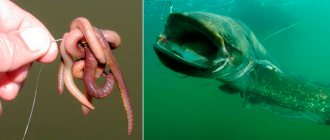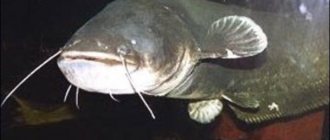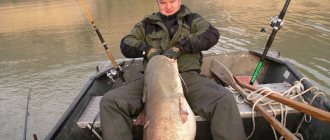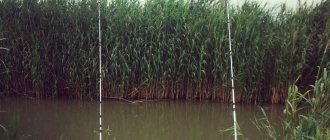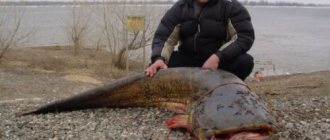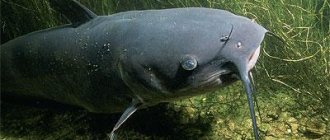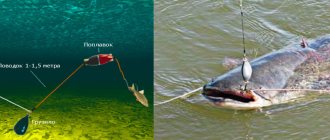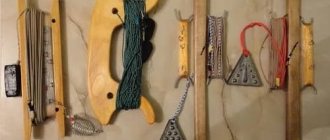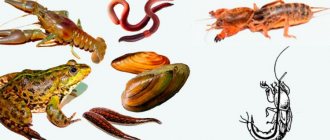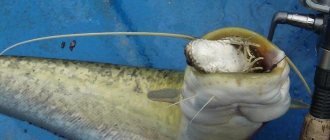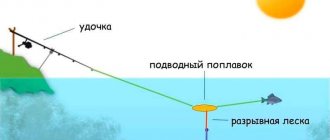Biting calendar
| January | February | March | April | May | June |
| — | — | — | — | + | +++ |
| July | August | September | October | November | December |
| +++ | +++ | + | — | — | — |
It is most often possible to catch the first catfish when the water becomes warmer than 10°C. In the spring, the fish bite improves as the temperature rises and turns into a feast before spawning. The fish bite all day. After spawning, catfish are well caught near the pits, but with the arrival of summer heat they switch to night feeding (summer fishing guide). On cloudy, rainy days, fish can feed during the daytime. Before wintering, the catfish feeds heavily, but the bite is inconsistent. Fish often change their tastes and feeding times.
When the catfish bites
This giant of our reservoirs is a rather heat-loving individual, showing its activity only at water temperatures above 12 degrees. Limits below this temperature parameter introduce the fish into a state of torpor and reduce its activity to zero. They begin to catch catfish in the spring, closer to mid-May, when stable, relatively warm weather sets in and the water in the reservoir reaches temperatures that do not fall below ten degrees even at night. But even these conditions do not guarantee a stable catfish bite.
As the water warms, small catfish begin to actively feed, coming out to the shallows closer to the shores, where small fish gather in schools. Sexually mature fish are preparing for the spawning season, which lasts throughout June. The feeding frequency of large catfish depends solely on favorable weather factors. The pre-spawning zhor reaches its peak on hot and quiet May days, or rather evenings and nights. Warm rains increase feeding intensity. On the eve of cold weather, the fish completely stop feeding again.
During spawning, the predator does not hunt, but is often caught in catches due to its excessive aggressiveness and especially noticeable among males. The fish lays on the clutch and zealously protects the nest from any suspicious objects, often becoming easy prey for trollers and jig lovers who successfully put the bait into the control zone. After the completion of the mating season, a time of stable and long biting begins, which continues until the water cools, which occurs closer to the month of October. During this period, catfish bites occur on animal baits of various origins. When planning fishing sessions, take into account sudden changes in weather towards colder weather. Only these cataclysms cause interruptions in fish nutrition. Transitions to heat, on the contrary, stimulate the mustachioed robber to intensive feeding.
Important! Quiet, warm and moonlit nights are the ideal time for hunting.
Good results also occur on warm, cloudy days with light drizzle. This weather allows you to count on catching a trophy throughout the day. The last burst of catfish bite occurs with the onset of Indian summer, often in mid-September. The cold snap that follows forces the already fattened fish to move to their wintering grounds and lie down in complete torpor for a long hibernation in deep wintering pits.
Catfish biting calendar by month
Catfish habitats
Catfish are common in large rivers and reservoirs in the middle zone and in the southern regions of the country. In rivers, reservoirs, and lakes it occupies the deepest holes. He spends the winter in them, being in a state of sleep. It emerges from the pits in the spring, when the water warms up to 8°C. But, once having chosen a hole, the fish spends most of its life in it and near it. At the beginning of summer, it visits creeks, bays, and shallows. After spawning, it stays at the entrances and exits of pits.
Catching catfish using a crawl
Catching catfish by crawling from the shore with bottom gear involves in itself the capture of large mustaches.
Therefore, special attention should be paid to the strength and reliability of the gear used. Catfish live in many of our reservoirs, and depending on their size and depth, they can grow up to 250 kg. Most often, fishermen deal with medium catfish weighing from 5 to 15 kg. Many people catch this fish purely for sport, and after a few clicks of the camera they release the mustachios to freedom. Catfish can be caught on anything except plant-based baits. His appetite is excellent, and he is unlikely to indifferently swim past a piece of slightly rotten meat, live or dead fish, chicken offal, frog or snail. The list of catfish baits could take a long time, so we’ll focus on the one that fishermen call the best. This is a worm. Since catfish is a rather large fish, the worm for catching it must also be large. In “our latitudes” there are few options, or more precisely, only one - this is a crawling worm. You simply cannot find a better bait for catching catfish weighing up to 15 kg. It may happen that a larger specimen becomes interested in crawling out, and the angler should always be prepared for this.
Method of installing the crawler
Success in catching catfish using a crawler largely depends on the presentation of the bait. If you save the worms and attach them one at a time, then this bait will most likely attract any other fish, but not catfish. To arouse his interest, you need to place 4-5 crawlers on the hook, piercing them with a sting in several places. The result should be a “live” appetizing lump that our predator will definitely be tempted by.
Spawning
Catfish reach sexual maturity at the age of five. Spawning occurs when the water temperature rises above 15°C. Spawning grounds can be in different places, both in shallows and deep bays. But usually these are quiet sections of a river or reservoir. Here the fish gather in groups and arrange special “lekking” events, when the males rub and wriggle against each other, giving the female a choice. Before spawning, the female digs a hole where she lays her eggs. For about 3-7 days, the fish guards the offspring, and when the larvae hatch, the catfish leave the spawning area and return to their holes.
Equipment for catching catfish using a crawler
Catching catfish with crawling worms involves using a strong bottom rod. Chinese spinning rods are not suitable for such fishing. Of course, you can fish with them, but there is a risk that a tackle broken during fishing will ruin your mood for a long time. The ideal rod in this case would be a plug rod about 3 meters long, consisting of two parts. Today, both professional fishermen and amateurs call the plug a reliable, practical tackle.
The fishing line should be no less reliable. It is advisable to settle on a diameter of 0.5 mm, and if bites of larger specimens occur in a pond, then instead of monofilament fishing line it is worth installing a braided cord of the same diameter. It is not recommended to use a hook that is too small; it is better if it is No. 10 or No. 12. The smaller the hook, the more difficult it is to place crawlers on it. The use of a Kevlar leash is allowed and even encouraged.
As for the reel, in addition to the already mentioned characteristics (strength and reliability), it must also be spacious. As a rule, they use a power spinning reel with a spool that can hold up to 200 meters of 0.5 mm fishing line.
Nutrition
The spring awakening of catfish coincides with the beginning of spawning of some fish species. This makes it possible for the sluggish giant to satisfy its hunger with fish that spawn. He does not disdain awakened frogs, worms, leeches and mollusks that have fallen into the water. After spawning, the catfish rushes to the shallows, where it hunts for fish, river lamprey, collects shells, insects and chicks that have fallen into the water. Mice, frogs, and snakes swimming across the river become prey for catfish. Often, a large predator grabs ducks and geese, as well as domestic animals that accidentally fall into the water.
Basic methods of catching catfish
There are dozens of different types of fishing. The most popular: fishing rod, spinning rod, coastal donka, quok, etc. You just need to always remember that this fish is bottom-dwelling. This means that the gear is compiled based on the specifics of bottom fishing.
Na kwok
The kwok comes in different structures.
The kwok is a kind of mallet, hitting the water with it will produce characteristic gurgling sounds. It is made from a variety of materials: wood, metal and mixtures. If you wish, you can buy a ready-made, factory-made one, of various designs.
Such a blow resembles a loud click. The barbel leaves its shelter and immediately heads towards the source of the sound. No one knows for sure what attracts him. Maybe it's just the call of a female, or ordinary curiosity.
It is not difficult to master the game of kwok; they make 5-6 strikes on the water with minimal depth. They pause and repeat again. But the best way is to fish from a boat.
To the donka from the shore
You can also catch it from the shore, but not a trophy specimen. If possible, position yourself next to a catfish hole, on the shallows. This will increase your chances significantly. From the shore, throw the bait within the reach of the fish.
Bottom tackle for catfish
The donka must be of special strength:
- Leash: Ø 0.2–0.16 mm.
- Monoline: 0.5-1 mm.
- For large individuals, a braid is needed: Ø 0.6–0.9 mm.
- Hooks: No. 10–16, for bait, tees are often used.
- Sinker (sliding): up to 120 g.
- The coil is at least 4000.
Leashes must be attached to a fishing line with a carabiner.
In the spring, large live baits up to 300 grams are used for bait: worms, live bait, loach, gudgeon, crawler . The catfish comes close to the shore, so there is no need to make long casts.
In summer - add locusts, shells, mole crickets and leeches . You need to start hunting only in the dark. Place the fishing rod on the stand, loosen the friction brake on the reel and install a bite alarm.
For spinning
Super Shad Rap
It should be very powerful:
- Length - 2.6-3 m.
- Test - 70-100 g.
- Reel - at least 200 m of line.
- Braid, up to 30 lb.
- For a twister, the cord is 50 lb.
If you have to hunt up to 20 kg, the tackle can be made shorter.
Lures: deep wobblers, spoons, jig baits.
An effective bait is a Super Shad Rap ; during retrieval it will emit a strong vibration.
Search for catfish sites
To catch catfish, an angler needs to look for the deepest parts of a river or reservoir using an echo sounder. The entrances and exits from them become the most catchy places. If not far from the hole there are steep banks, pools, trees and bushes bent over the water, then the catfish may appear here to feed. Before spawning, you should look for fish at a depth of 1-2 m, which is adjacent to the riverbed or hole. Bays and creeks at the beginning of summer are also promising for catching freshwater giants. The catfish rises to the surface only on clear moonlit nights, as well as during a thunderstorm. In the fall, he is one of the first to go to wintering pits.
Where is the catfish hiding?
As you know, catfish love holes and pools. You can find it under steep banks. The ideal habitat for the predator is the exit area from the pit, characterized by abundant vegetation.
Catfish go out in search of food after sunset. But he doesn’t go far from his home. He will not hunt in distant territories. The predator prefers to wait until the prey swims into its mouth. By the way, there may well be several small individuals in one hole.
To accurately determine the catfish's habitat, it is worth observing the reservoir. The predator will give itself away with powerful bursts during the hunting period. Since the catfish does not go far from its lair, prey should be expected in the designated territory.
I often go to the Sazanya Bay fishing base. There are ideal conditions for catching large catfish. The characteristics of the reservoirs and food supply make it possible to catch excellent specimens. Night fishing gives me special pleasure. Testing your strength with such a predator as a catfish is a very exciting activity.
TAGS:
Artificial baits for spinning fishing
There are many artificial baits for spinning; the list of them can take a very long time. But the most catchy ones for the mustachioed predator are wobblers, spinners and silicone.
Wobbler
floating wobblers - they are equipped with a blade and have an average diving depth. Great for the summer season, near the dams of huge rivers. After darkening, the barbels swim into shallow water, in places where small things accumulate.
They drive the wobblers in jerky movements, pausing so that the bait can float up. The barbel always bites when the wobbler starts moving again. The length of the wobblers should be 20 cm.
Rapala Countdown Magnum 22
Sinking - when the temperature drops in the fall, catfish move to deeper layers, and that’s where you need to look for them. The best bait at this time will be wobblers, sinking with a semi-passive game. Postings must be done slowly. Hunting at this time:
- rivers - in whirlpools, next to the harbor.
- lakes - in deep-sea places.
A very good wobbler from Rapala Magnum .
The fish is inactive at this time, and therefore you need to give it a little rest by stopping the bait.
Silicone
Large edible and inedible silicone fish (10-25 cm) are suitable for spinning, especially in spring and autumn. At this time it lies in the bottom layers.
On the river, silicone is used in whirlpools near dams, at the confluence of two rivers, etc.
In lakes - at depth, near catfish shelters. Barbel has a good sense of smell, so the fish should not have a pungent synthetic smell. You can treat it with purchased flavorings, or keep it in a bag with fish for a couple of days.
Spoon
Effzett
Barbel are very tempted by the loud sound of bait. For night hunting, a heavy spoon is suitable, for example, a two-layer one - Effzett . It makes noise when lowering and a clicking sound when moving.
To explore a place and fish, you can throw the bait into the same place 20-30 times without worrying about the noise it makes.
This individual bites on a noisy bait only after it has been repeatedly lowered into the water.
When using this wiring technique, you need to pay special attention to the speed of regaining control of the nozzle. Because when hunting for a lure, the bite can begin almost immediately after casting.
